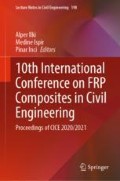Abstract
Bamboo is a kind of a green renewable traditional building material with the advantages of high tensile strength parallel to grain and fast growth, which can meet the development needs of green and ecological fabricated buildings. However, the round bamboos are likely to crack under pressure, especially at the bottom of the column and bolted bamboo joint, because of stress concentration. To solve the above problems, glass fiber reinforced polymer (GFRP) was used to strengthen the natural bolted bamboo joints in this study. Then shear tests and pressure tests were carried out in order to find an effective way to improve the compression resistance capability of the bamboo column and shear behavior of bolted bamboo joint. The bearing capacity and failure modes were observed and studied. Compared with the specimens without reinforcement, the maximum deformation capacity of the GFRP reinforced bamboo column specimens is increased by at least 2.5 times, and the bearing capacity is increased by 5.5%–11.7%; the maximum deformation capacity of the GFRP reinforced bamboo joint specimens is increased by at least 2.5 times, and the bearing capacity is increased by 3–6 times. Therefore, GFRP is a kind of material which can greatly improve the deformation and bearing capacity of bamboo column or bolted bamboo joint. In addition, GFRP can prevent brittle failure and improve ductility of specimens.Although the bearing capacity of GFRP reinforced bamboo joints has been greatly improved compared with that without reinforcement and the stress has also been greatly enhanced, the maximum load that the bamboo joint can bear is still far lower than that of the bamboo column due to the lack of bearing area. How to make full use of the bearing capacity of bamboo in addition to the node is the key point to be solved in the future, one suggestion is to add fillers to bamboo joints.
Access this chapter
Tax calculation will be finalised at checkout
Purchases are for personal use only
References
Tan T, Rahbar N, Allameh SM et al (2011) Mechanical properties of functionally graded hierarchical bamboo structures. Acta Biomater 7(10):3796–3803
Habibi MK, Samaei AT, Gheshlaghi B et al (2015) Asymmetric flexural behavior from bamboo’s functionally graded hierarchical structure: underlying mechanisms. Acta Biomater 16:178–186
Nogata F, Takahashi H (1995) Intelligent functionally graded material: bamboo. Compos Eng 5(7):743–751
Amada S, Ichikawa Y, Munekata T et al (1997) Fiber texture and mechanical graded structure of bamboo. Compos B Eng 28(1–2):13–20
Yu D, Tan H, Ruan Y (2011) A future bamboo-structure residential building prototype in China: life cycle assessment of energy use and carbon emission. Energy and Buildings 43(10):2638–2646
Dixon PG, Muth JT, Xiao X, Skylar-Scott MA, Lewis JA, Gibson LJ (2018) 3D printed structures for modeling the Young's modulus of bamboo parenchyma. Acta Biomaterialia 68
Teng JG, Chen JF, Smith ST, et al (2002) FRP strengthened RC structures. Front Phys :266
Yan X, Jia L (2015) The state of the art of modern bamboo structures. Industrial Construction
Morisco (1999) Rekayasa Bambu. Nafiri Offset, Yogyakarta
Johansen KW (1949) Theory of Timber Connections, International Association of Bridges and Structural Engineering Publication. IABSE 9:249–262
Author information
Authors and Affiliations
Corresponding author
Editor information
Editors and Affiliations
Rights and permissions
Copyright information
© 2022 The Author(s), under exclusive license to Springer Nature Switzerland AG
About this paper
Cite this paper
Zhang, Z., Meng, X., Zhai, J., Feng, P. (2022). Experimental Study on Mechanical Properties of Bamboo Culms and Joints Reinforced with GFRP Sheets. In: Ilki, A., Ispir, M., Inci, P. (eds) 10th International Conference on FRP Composites in Civil Engineering. CICE 2021. Lecture Notes in Civil Engineering, vol 198. Springer, Cham. https://doi.org/10.1007/978-3-030-88166-5_139
Download citation
DOI: https://doi.org/10.1007/978-3-030-88166-5_139
Published:
Publisher Name: Springer, Cham
Print ISBN: 978-3-030-88165-8
Online ISBN: 978-3-030-88166-5
eBook Packages: EngineeringEngineering (R0)

